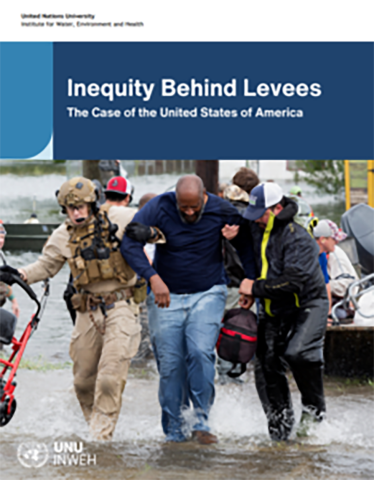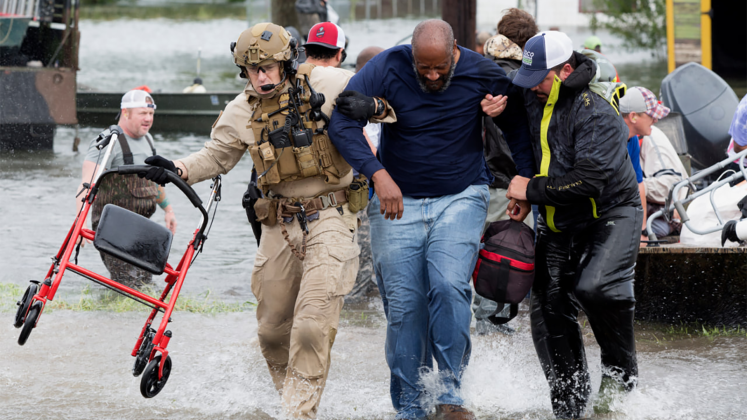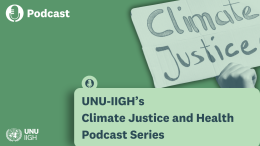Vahedifard, F., Azhar, M., Brown, D. C,, Madani, K.. 2023. Inequity Behind Levees: The Case of the United States of America. United Nations, University Institute for Water, Environment and Health (UNU-INWEH), Hamilton, Canada, https://go.unu.edu/rtlCm.
Download the report

This report investigates the population characteristics of the communities living behind levees in the United States of America to highlight how the social, economic, and demographic disparities of population groups behind levees can make some of these communities highly vulnerable to floods and levee failures. As the world prepares to take serious mitigation and adaptation action on climate change, such inequity and injustice implications call for a major reform in current flood management practices.
Fulfilling justice and equity will not be an achievable goal if risk mitigation and climate change adaptation strategies are designed without a comprehensive assessment of diversity in the levels of vulnerability of different population groups and communities. Thus, this report intends to highlight how and why the failure of aging human-made infrastructure under climate change and natural hazards can differently affect people with various economic, social, and demographic conditions. The investigation is focused on the United States to underline the fact that the injustice and inequity implications of human- and nature-made hazards are significant even in the Global North and advanced economies.
The analysis results quantitatively describe disparities in flood risk exposure among historically underserved and socially vulnerable communities at the state, regional, and national geographical scales in the United States. The investigation reveals that average levels of social and economic disadvantage are higher among populations in leveed areas than non-leveed areas within the United States. Specifically, the study finds that members of racial and ethnic minority groups, poor households, disabled persons, and persons without high school diplomas are overrepresented in leveed communities in comparison to non-leveed communities. While the findings are alarming, they can inform decision-makers on which communities require priority for flood mitigation and adaptation actions.
Comparison of the sociodemographic and socioeconomic composition of leveed and non-leveed U.S. communities show a substantial overrepresentation of historically underserved and socially vulnerable communities in leveed areas at the state, regional, and national levels. According to the study results, Hispanics are the most overrepresented population in leveed areas yielding a disparity percentage of 39.9%, followed by Native American (18.7%), Asian (17.7%), and Black (16.1%) communities. Communities characterized by low education, poverty, and disability exhibit a disproportionately higher presentation of 27.8%, 20.4%, and 5.4% in leveed areas across the U.S. In 43 states, disadvantaged communities are overrepresented behind levees, with a national disparity percentage of 40.6%. At the regional level, the highest disparity was observed in the Northeast (57.3%), followed by the West (51.3%), Southeast (38%), Midwest (29.2%), and Southwest (25%). Regionally, in the U.S. Midwest and Southeast, respectively, 60.6% and 40.2% more Black populations live behind levees. In the Western U.S., the largest disparities are related to people with low levels of education (40.5%) and Hispanic or Latino populations (38.6%).
The report calls for targeted action to ensure that future flood mitigation and climate change adaptation strategies prioritize those most at risk. Incorporating principles of environmental justice into future decision-making regarding flood management and infrastructure resilience under climate change has the potential to foster a more resilient and equitable society by ensuring that policy decisions take into account the concerns of the socially and economically vulnerable populations who disproportionately face human-made and natural hazards and disasters around the world.
KEY FINDINGS
- Historically underserved and socially vulnerable communities are substantially over-represented in levee-protected areas at the national, regional, and state levels within the United States.
- Disadvantaged communities are overrepresented behind levees in 43 states with a national disparity of 40.6%. Regionally, the highest disparities exist in the Northeast (57.3%), followed by the West (51.3%), Southeast (38%), Midwest (29.2%), and Southwest (25%).
- In terms of race and ethnic composition, Hispanic communities are most overrepresented in leveed areas (39.9%), followed by Native American (18.7%), Asian (17.7%), and Black (16.1%) communities.
- Residents in levee-protected communities exhibit disproportionately low educational attainment (27.8%), poverty (20.4%), and disability (5.4%) when compared to residents in communities not protected by levees.
- At the national level, Black and Asian populations exhibited disproportionate representation behind high to very high-risk levees, with disparity percentages of 74.1% and 68.8%, respectively.
- Substantial overrepresentation of Native Americans was found in areas protected by non-classified levees (82.5%), and non-accredited levees (76.7%).
Read the press release here
Suggested citation: "Inequity Behind Levees: The Case of the United States of America," United Nations University, UNU-INWEH, 2023-09-05, https://unu.edu/inweh/article/inequity-behind-levees-case-united-states-america.




